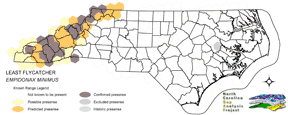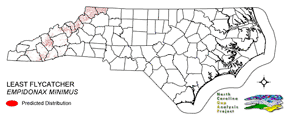
| Taxa: |
| Order: |
| Family: |
| Aves |
| Passeriformes |
| Tyrannidae |
| NatureServe Global Rank: |
| NatureServe State (NC) Rank: |
| G5 |
| S3B,SZN |
| Federal Status: |
| NC State Status: |
| --- |
| W2 |


| Land Unit |
| US Fish & Wildlife Service |
| US Forest Service |
| US National Park Service |
| US Department of Defense |
| NC State Parks |
| NC University System |
| NC Wildlife Res. Com. |
| NC Forest Service |
| NC Div. of Coastal Mgmt. |
| Local Governments |
| Non-Governmental Org. |
| Other Public Lands |
| Private Lands |
| GAP Status 1-2 |
| All Protected Lands |
| Statewide |
| Hectares |
| 0.00 |
| 6,834.42 |
| 0.00 |
| 1,789.29 |
| 119.79 |
| 2.88 |
| 93.87 |
| 185.79 |
| 0.00 |
| 62.37 |
| 133.47 |
| 35.19 |
| 105,718.50 |
| 2,440.83 |
| 9,215.49 |
| 114,975.57 |
| Acres |
| 0.00 |
| 16,888.22 |
| 0.00 |
| 4,421.43 |
| 296.01 |
| 7.12 |
| 231.96 |
| 710.55 |
| 0.00 |
| 154.12 |
| 329.81 |
| 86.96 |
| 261,236.05 |
| 6,282.88 |
| 23,023.42 |
| 284,362.22 |
| % of Dist. on |
| Prot. Lands |
| 0.0 % |
| 74.2 % |
| 0.0 % |
| 19.4 % |
| 1.3 % |
| < 0.1 % |
| 1.0 % |
| 2.0 % |
| 0.0 % |
| 1.4 % |
| 1.4 % |
| 0.0 % |
| 0.0 % |
| 26.5 % |
| ----- |
| ----- |
| % of Dist. on |
| All Lands |
| 0.0 % |
| 5.9 % |
| 0.0 % |
| 1.6 % |
| 0.1 % |
| < 0.1 % |
| < 0.1 % |
| 0.2 % |
| 0.0 % |
| < 0.1 % |
| 0.1 % |
| < 0.1 % |
| 91.9 % |
| 2.1 % |
| ----- |
| ----- |
|
Found in the mountains (Potter et al 1980, Simpson 1992). Found in open woodlands, such as old orchards or groves, also in woodland strips bordering streams or fields, generally avoiding deep woods (Hamel 1992, Potter et al 1980). In addition, Briske (1994) describes this flycatcher as preferring drier habitat in 'semi-open, secondary growth, and mature deciduous and mixed woods.' Nest usually in 'deciduous sapling or small tree, such as maple, birch, and ash (Kaufman 1996). Generally it is built in the lower to middle part of the canopy (Briske 1994), with an averaging height of 12 to 25 feet (Kaufman 1996). Commonly the nest is constructed of bark strips and fibers, grasses, spider webs, lichens, hairs, feathers, twigs, rootlets, mosses, pine needles, and lined with fine grasses, feathers, animal hair, thistle or willow down, and plant stems (Briske 1994). The Least Flycather hunts insects by hawking or gleaning 'from top of shrub stratum up to leafy canopy of forest overstory,' according to Briske (1994). NATURE SERVE GLOBAL HABITAT COMMENTS: Open woodland and brushy areas, forest borders, thinned woodland, tall second growth. In maple forests in Quebec, occurred where trees were the tallest, sugar maple was in nearly pure stand, and subcanopy was sparse (Darveau 1992). Nests in poplar woodland, deciduous scrub, forest edge, parks, old orchards, roadside shade trees, and gardens; in crotch or on limb of tree (often deciduous) or shrub, often 3-6 m above ground. |
| Code | Name | Description | NC Natural Heritage Program Equivalent |
| 205 | Agricultural Pasture/Hay and Natural Herbaceous | Farm fields used for pasture grass or hay production, as well as old fields dominated by native and exotic grasses. | No equivalent |
| 202 | Residential Urban | Includes vegetation interspersed in residential areas. Includes lawns, mixed species woodlots, and horticultural shrubs. Vegetation accounts for between 20 - 70% of the cover. | No equivalent |
| 517 | Hemlock Floodplain Forest | Alluvial forest with hemlock and/or white pine in mountains and western piedmont. Hydrology is generally temporarily to seasonally flooded. | Canada Hemlock Forest |
| 522 | Northern Hardwoods | High Elevation forests including yellow birch, American beech, and yellow buckeye. Includes forests with Hemlock and Yellow Birch. | Northern Hardwoods Forest, Boulderfield Forest |
| 523 | Grassy Bald | High Elevation grassy balds including Pennsylvania sedge, mountain oatgrass, as well as shrubby areas dominated by Alleghany and smooth blackberry. | Grassy Bald |
| 524 | Shrub Bald | Variable phenologies, predominantly evergreen balds with rhododendon and Mountain laurels. Deciduous shrubs including green alder and Alleghany and smooth blackberry are included as well. Red Oak - Chestnut Oak Woodlands may be included in cases where the density of the woodland species is low and the shrub component is dense. | Heath Bald |
| 525 | Appalachian Oak Forest | A variety of oak forest types including Black, White, Scarlet Oaks in dry to mesic situations. Includes forests historically co-dominated by American Chestnut. | High Elevation Red Oak Forest, Montane White Oak Forest |
| 526 | Appalachian Cove Forest | Mixed Mesophytic forests of the mountains. Includes tuliptree, basswood, yellow buckeye and surgar maple. This class is mapped to include cove forests dominated or co-dominated by hemlock. | Rich Cove Forest, Acidic Cove Forest |
| 527 | Appalachian Hemlock | Upland hemlock forests of the moutains region. Vary from side slopes to steep slope positions. | Canada Hemlock Forest |
| 529 | Appalachian Xeric Mixed Forest | Mixed forests with Virginia, Shortleaf, Eastern White Pine, Table Mountain and Pitch pines in combination with xeric oak species. Oaks include, white, Southern Red, black, and rock chestnut. | Pine Oak Heath |
| 530 | Appalachian Xeric Deciduous Forest | Deciduous forests in the mountains dominated by Xeric Oak species. Species include, white, Southern red, black, and rock chestnut. | High Elevation Red Oak Forest, Montane White Oak Forest |
|
Darveau, M., et al. 1993. Nesting success, nest sites, and parental care of the least flycatcher in declining maple forests. Can. J. Zool. 71:1592-1601.
Banks, R. C., and M. R. Browning. 1995. Comments on the status of revived old names for some North American birds. Auk 112:633-648. Bent, A.C. 1942. Life histories of North American flycatchers, larks, swallows, and their allies. U.S. National Museum Bulletin 179. Washington, DC. Ehrlich, P.R., D.S. Dobkin, and D. Wheye. 1992. Birds in jeopardy:the imperiled and extinct birds of the United States and Canada, including Hawaii and Puerto Rico. Stanford University Press, Stanford, California. 259 pp. Hagan, J.M., III, and D.W. Johnston, editors. 1992. Ecology and conservation of neotropical migrant landbirds. Smithsonian Institution Press, Washington, D.C. xiii + 609 pp. Hamel, P. B. 1992. The land manager's guide to the birds of the south. The Nature Conservancy, Chapel Hill, North Carolina. 367 pp + several appendices. Simpson MB Jr. 1992. Birds of the Blue Ridge Mountains. Chapel Hill and London: University of North Carolina Press. Sauer, J.R., and S. Droege. 1992. Geographical patterns in population trends of neotropical migrants in North America. Pages 26-42 in J.M. Hagan III and D.W. Johnston, editors. Ecology and conservation of neotropical migrant landbirds. Smithsonian Institu Rappole, J.H., and D.W. Warner. 1980. Ecological aspects of migrant bird behavior in Veracruz, Mexico. Pages 353-393 in A. Keast and E.S. Morton, editors. Migrant birds in the neotropics:ecology, behavior, distribution, and conservation. Smithsonian Insti Briske, J. V. 1994. Least flycatcher. In Poole, A. and F. Gill, eds. The birds of North America. No. 99. Sherry, T. W., and R. T. Holmes. 1988. Habitat selection by breeding American redstarts in response to a dominant competitor, the least flycatcher. Auk 105:350-364. Kaufman K. 1996. Lives of North American Birds. Boston, New York: Houghton Mifflin Company. Harrison, C. 1978. A field guide to the nests, eggs and nestlings of North American birds. Collins, Cleveland, Ohio. Harrison, H.H. 1979. A field guide to western birds' nests. Houghton Mifflin Company, Boston. 279 pp. Keast, A., and E. S. Morton. 1980. Migrant birds in the Neotropics; ecology, distribution, and conservation. Smithsonian Inst. Press, Washington, D.C. Potter, E. F., J. F. Parnell, and R. P. Teulings. 1980. Birds of the Carolinas. Univ. North Carolina Press, Chapel Hill. 408 pp. Terres, J.K. 1980. The Audubon Society encyclopedia of North American birds. Alfred A. Knopf, New York. Whitney, B., and K. Kaufmann. 1985. The EMPIDONAX challenge. Looking at EMPIDONAX. Part II:least, Hammond's, and dusky flycatchers. Birding 17:277-287. American Ornithologists' Union (AOU), Committee on Classification and Nomenclature. 1983. Check-list of North American Birds. Sixth Edition. American Ornithologists' Union, Allen Press, Inc., Lawrence, Kansas. National Geographic Society (NGS). 1983. Field guide to the birds of North America. National Geographic Society, Washington, D.C. Stiles, F.G., and A.F. Skutch. 1989. A guide to the birds of Costa Rica. Comstock Publ. Associates, Cornell University Press, Ithaca, New York. 511 pp. Darveau, M., J. L. DesGranges, and G. Gauthier. 1992. Habitat use by three breeding insectivorous birds in declining maple forests. Condor 94:72-82. |
For more information please contact them at:
NC-GAP Analysis Project
Dept. of Zoology, NCSU
Campus Box 7617
Raleigh, NC 27695-7617
(919) 513-2853
www.basic.ncsu.edu/ncgap